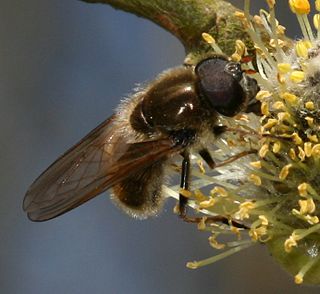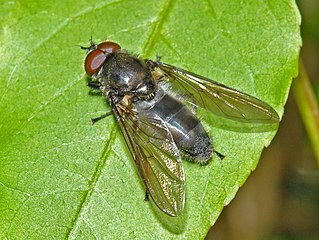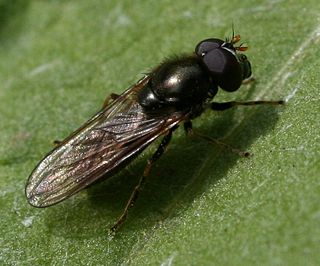
Hover flies, also called flower flies or syrphid flies, make up the insect family Syrphidae. As their common name suggests, they are often seen hovering or nectaring at flowers; the adults of many species feed mainly on nectar and pollen, while the larvae (maggots) eat a wide range of foods. In some species, the larvae are saprotrophs, eating decaying plant and animal matter in the soil or in ponds and streams. In other species, the larvae are insectivores and prey on aphids, thrips, and other plant-sucking insects.

Cheilosia albipila is a European and Palearctic species of hoverfly. Like most Cheilosia it is black, and because of this may often be overlooked as a hoverfly. It is little recorded but probably widespread and common and maybe overlooked because adult flight periods are early in the year, before many hoverfly recorders are active.

Cheilosia is a genus of hoverfly. Most Cheilosia are black or largely un-coloured, lacking the bright colours and patterns of many hoverfly species. It is one of the most species diverse genera of hoverflies. The biology of many species is little understood, but where known, the larvae of Cheilosia species feed in the stems of plants or in fungi.

Cheilosia variabilis, common name figwort cheilosia, is a species of hoverfly belonging to the family Syrphidae.

Cheilosia pagana is a Holarctic species of hoverfly. Like most Cheilosia it is black, and because of this may often be overlooked as a hoverfly. One identifying feature is a large red to orange 3rd antennal segment.

The Brachyopini is a tribe of hoverflies. Unlike many members of this family these flies are generally darker and less colourful though some genera contain species with an attractive metallic lustre e.g. Chrysogaster. Some like Brachyopa are associated with sap runs where their larvae feed on decaying sap. Others are found in boggy areas where their often semiaquatic larvae feed on decaying organic matter.

Cheilosia grossa is a widespread European species of hoverfly. Adults can be found in spring on sallow catkins and the larvae tunnel in the stems of various thistle species.

Cheilosia albitarsis is an abundant European species of hoverfly. Adults can be found in spring visiting buttercup flowers and this plant is also the larval hostplant.
Lutzomyia shannoni is a species of fly in the subfamily Phlebotominae, the phlebotomine sand flies. It is native to the Americas from the southeastern United States to northern Argentina. It has a disjunct distribution, and is only found in regions with suitable climates, habitat types, and host animals. It is well known as a vector of the vesicular stomatitis virus, which causes the disease vesicular stomatitis in animals, particularly livestock.
Gaurax shannoni is a species of frit fly in the family Chloropidae.

Limnia shannoni is a species of marsh fly in the family Sciomyzidae.
Dixella is a genus of meniscus midges in the family Dixidae. There are more than 70 described species in Dixella.
Limonia shannoni is a species of limoniid crane fly in the family Limoniidae.

Cheilosia psilophthalma is a Palearctic hoverfly closely related and very similar to Cheilosia latigenis, Cheilosia mutabilis and Cheilosia urbana . It is a rare and little known species recorded from Scandinavia, Ireland, Britain, France, Poland, Switzerland, Greece, Montenegro, Serbia, Ukraine and European Russia. Flowers visited include Acer platanoides, Anemone nemorosa, Primula veris, Prunus spinosa and Salix spp. Cheilosia psilophthalma flies in April and May. Open, grassy areas within sparse woodland and unimproved, montane subalpine grassland are preferred habitats. Larvae are recorded as developing in Hieracium pilosella and Hieracium caespitosum.
Cheilosia bardus is a species of hoverfly belonging to the family Syrphidae.
Cheilosia orilliaensis, the black-backed blacklet, is a common species of syrphid fly observed across North America. Hoverflies can remain nearly motionless in flight. The adults are also known as flower flies for they are commonly found on flowers, from which they get both energy-giving nectar and protein-rich pollen. Larvae when known are plant feeders.
Cheilosia rita the inky blacklet, is a fairly common species of syrphid fly observed in The United States and Canada. Hoverflies can remain nearly motionless in flight. The adults are also known as flower flies for they are commonly found on flowers, from which they get both energy-giving nectar and protein-rich pollen. The larvae, when they are known, are plant feeders.
Total of 245 species either found or highly expected to be found in New York.
Hiatomyia cyanea, the mountain deltawing, is a rare species of syrphid fly observed in the northwestern United States .Hoverflies can remain nearly motionless in flight. The adults are also known as flower flies for they are commonly found on flowers from which they get both energy-giving nectar and protein-rich pollen. The larvae are unknown.









